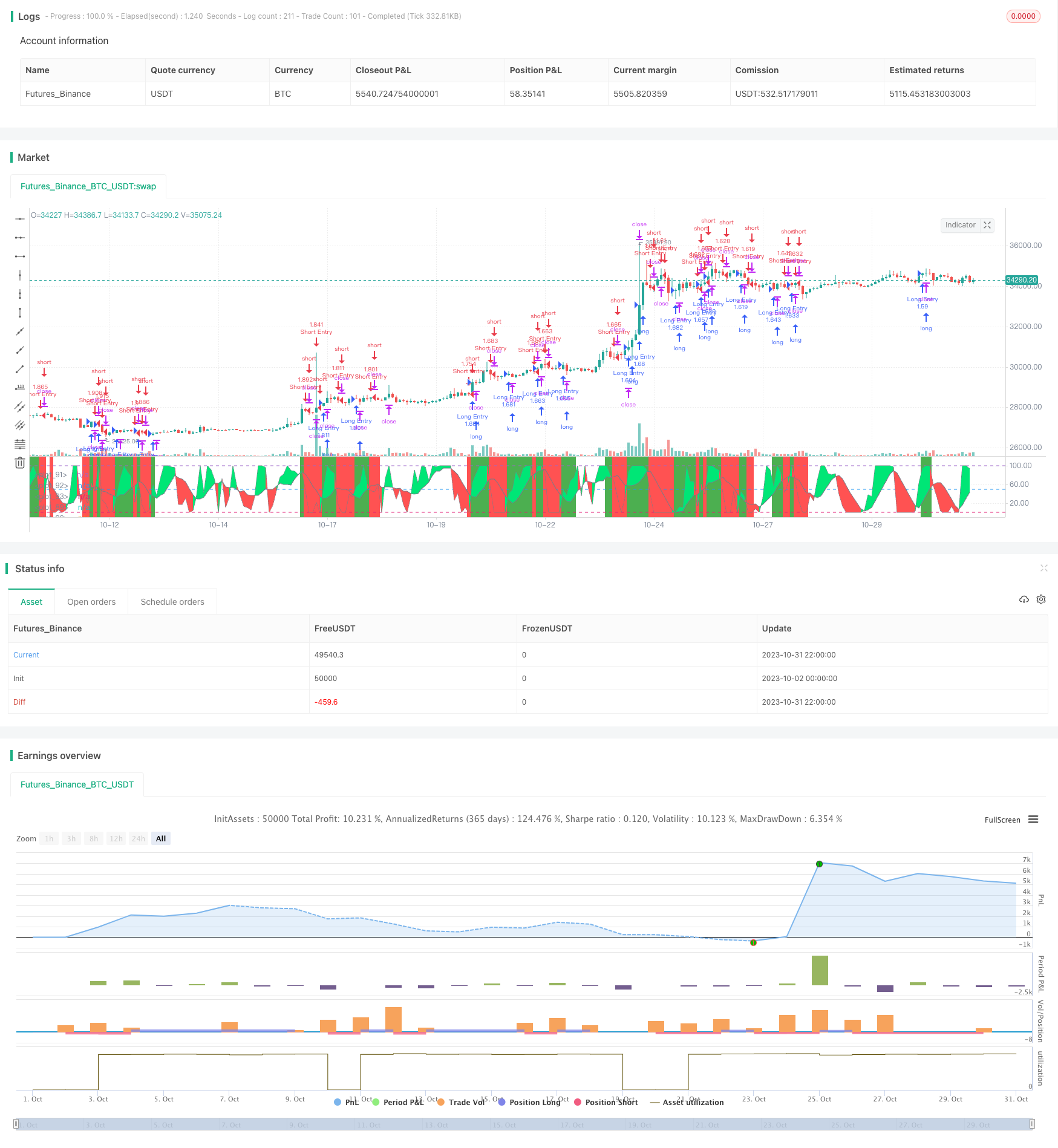
概述
该策略使用Stochastic RSI和价格变动率指标,识别趋势方向进入多空单,并使用坐标滑动止损方法进行风险管理。
策略原理
首先,策略使用长度为5的RSI指标和长度为7的Stochastic指标计算Stochastic RSI。当Stochastic RSI的K值高于D值时为看涨信号,K值低于D值时为看跌信号。
其次,策略计算价格的变动率指标EMA ROC。当EMA ROC高于阈值的一半或低于阈值的负一半时,认为价格在活跃变动。
然后,结合Stochastic RSI的多空信号和价格变动率指标,可以识别趋势方向。当Stochastic RSI看涨且价格活跃变动时,做多;当Stochastic RSI看跌且价格活跃变动时,做空。
最后,该策略使用坐标滑动止损方式管理风险。在开仓后,继续刷新最高价或最低价,并以一定比例距离最高价或最低价作为止损位。
优势分析
该策略具有以下优势:
使用Stochastic RSI指标可以有效识别趋势和超买超卖情况。
价格变动率指标可以过滤掉震荡盘整的市场,避免假信号。
坐标滑动止损方式可以最大程度锁定盈利,同时也能控制风险。
策略参数优化空间大,可以针对不同品种进行调整。
策略思路简单清晰,容易理解实现。
风险分析
该策略也存在一些风险:
Stochastic RSI可能产生假信号,需要结合其他因素确认。
坐标滑动止损可能过于激进,被隔夜gaps击出。
短期内反转可能导致止损被触发。
策略参数需要针对不同品种进行优化,否则效果可能不佳。
交易成本会影响策略盈利能力,需要考虑合理的交易频率。
优化方向
该策略还可以从以下几个方面进行优化:
优化Stochastic RSI参数,降低假信号率。可以测试不同的K值和D值参数。
优化价格变动率指标参数,提高过滤效果。可以测试不同的窗口期和变动率阈值。
结合趋势判断指标,避免被反转止损。例如添加移动平均线等指标。
优化止损比例,降低被套风险。可以测试不同的止损幅度。
添加仓位数管理,控制单笔风险。例如固定止损金额,或根据账户余额动态调整仓位。
测试不同品种参数,提高适应性。优选在多市场多时间周期验证。
总结
该策略整体思路清晰简单,使用Stochastic RSI识别趋势方向,并配合价格变动率指标过滤信号,可以有效捕捉中长线趋势机会。坐标滑动止损方式可以锁定盈利同时控制风险。通过进一步优化,该策略可以成为一个非常实用的趋势跟踪策略。
/*backtest
start: 2023-10-02 00:00:00
end: 2023-11-01 00:00:00
period: 2h
basePeriod: 15m
exchanges: [{"eid":"Futures_Binance","currency":"BTC_USDT"}]
*/
//@version=4
strategy("Sto2", overlay=false, initial_capital=10000, default_qty_type=strategy.percent_of_equity, default_qty_value=100, commission_type=strategy.commission.percent, commission_value=0.0)
/////////////// Time Frame ///////////////
testStartYear = input(2017, "Backtest Start Year")
testStartMonth = input(1, "Backtest Start Month")
testStartDay = input(1, "Backtest Start Day")
testPeriodStart = timestamp(testStartYear,testStartMonth,testStartDay, 0, 0)
testStopYear = input(2019, "Backtest Stop Year")
testStopMonth = input(12, "Backtest Stop Month")
testStopDay = input(31, "Backtest Stop Day")
testPeriodStop = timestamp(testStopYear,testStopMonth,testStopDay, 0, 0)
testPeriod() => true
///////////// Stochastic calc /////////////
smoothK = input(1, minval=1)
smoothD = input(7, minval=1)
lengthRSI = input(5, minval=1)
lengthStoch = input(7, minval=1)
src = input(close, title="RSI Source")
up = sma(max(change(src), 0), lengthRSI)
down = sma(-min(change(src), 0), lengthRSI)
rsi1 = down == 0 ? 100 : up == 0 ? 0 : 100 - (100 / (1 + up / down))
k = sma(stoch(rsi1, rsi1, rsi1, lengthStoch), smoothK)
d = sma(k, smoothD)
///////////// Rate Of Change /////////////
source = close, roclength = input(14, minval=1), pcntChange = input(2, minval=1)
roc = 100 * (source - source[roclength]) / source[roclength]
emaroc = ema(roc, roclength / 2)
isMoving() => emaroc > (pcntChange / 2) or emaroc < (0 - (pcntChange / 2))
/////////////// STRATEGY ///////////////
long = k > d and isMoving()
short = k < d and isMoving()
last_long = 0.0
last_short = 0.0
last_long := long ? time : nz(last_long[1])
last_short := short ? time : nz(last_short[1])
long_signal = crossover(last_long, last_short)
short_signal = crossover(last_short, last_long)
last_open_long_signal = 0.0
last_open_short_signal = 0.0
last_open_long_signal := long_signal ? open : nz(last_open_long_signal[1])
last_open_short_signal := short_signal ? open : nz(last_open_short_signal[1])
last_long_signal = 0.0
last_short_signal = 0.0
last_long_signal := long_signal ? time : nz(last_long_signal[1])
last_short_signal := short_signal ? time : nz(last_short_signal[1])
in_long_signal = last_long_signal > last_short_signal
in_short_signal = last_short_signal > last_long_signal
last_high = 0.0
last_low = 0.0
last_high := not in_long_signal ? na : in_long_signal and (na(last_high[1]) or high > nz(last_high[1])) ? high : nz(last_high[1])
last_low := not in_short_signal ? na : in_short_signal and (na(last_low[1]) or low < nz(last_low[1])) ? low : nz(last_low[1])
sl_inp = input(2.0, title='Stop Loss %') / 100
tp_inp = input(9.0, title='Take Profit %') / 100
take_level_l = strategy.position_avg_price * (1 + tp_inp)
take_level_s = strategy.position_avg_price * (1 - tp_inp)
since_longEntry = barssince(last_open_long_signal != last_open_long_signal[1]) // LONG SL
since_shortEntry = barssince(last_open_short_signal != last_open_short_signal[1]) // SHORT SL
slLong = in_long_signal ? strategy.position_avg_price * (1 - sl_inp) : na
slShort = strategy.position_avg_price * (1 + sl_inp)
long_sl = in_long_signal ? slLong : na
short_sl = in_short_signal ? slShort : na
// Strategy
if testPeriod()
strategy.entry("Long Entry", strategy.long, when=long)
strategy.entry("Short Entry", strategy.short, when=short)
strategy.exit("Long Ex", "Long Entry", stop=long_sl, limit=take_level_l, when=since_longEntry > 0)
strategy.exit("Short Ex", "Short Entry", stop=short_sl, limit=take_level_s, when=since_shortEntry > 0)
///////////// Plotting /////////////
bgcolor(isMoving() ? long ? color.green : short ? color.red : na : color.white, transp=80)
p1 = plot(k, color=color.gray, linewidth=0)
p2 = plot(d, color=color.gray, linewidth=0)
h0 = hline(100)
h1 = hline(50)
h3 = hline(0)
fill(p1, p2, color = k > d ? color.lime : color.red, transp=70)